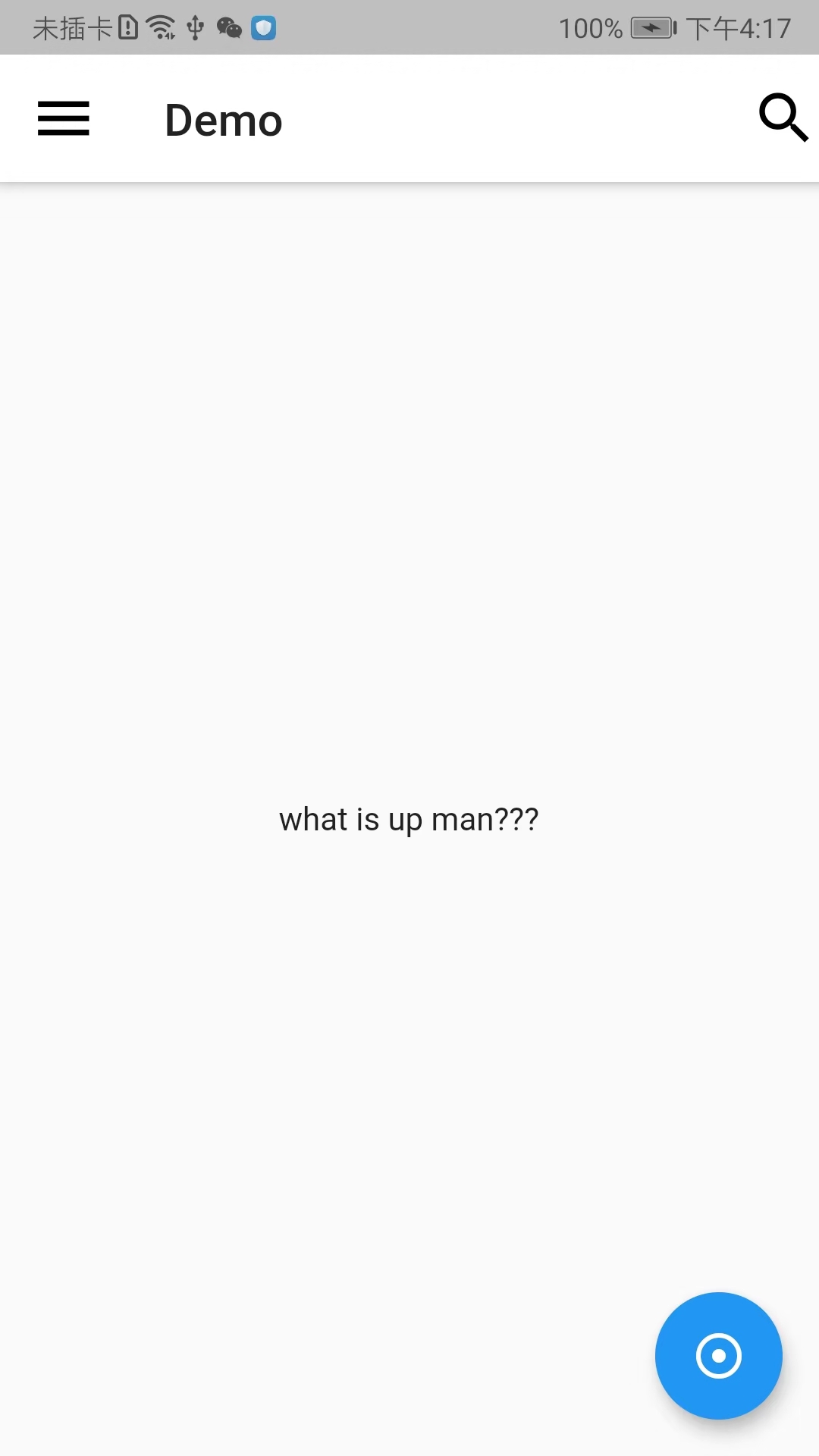如需转载,请注明出处:flutter学习笔记(29)--flutter如何与native进行通信
前言:在我们开发flutter项目的时候,难免会遇到需要调用native api或者是其他的情况,这时候就需要处理flutter与native的通信问题,一般常用的flutter与native的通信方式有3中。
1.methodchannel:flutter端向native端发送通知,通常用来调用native的某一个方法。
2.eventchannel:用于数据流的通信,有监听功能,比如电量变化后直接推送给flutter端。
3.basicmessagechannel:用于传递字符串或半结构体的数据。
接下来具体看一下每种通信方式的使用方法!
先来整体说一下逻辑思想吧,这样能更容易理解一些,如果想要实现flutter与native通信,首先要建立一个通信的通道,通过一个通道标识来进行匹配,匹配上了之后flutter端通过invokemethod调用方法来发起一个请求,在native端通过onmethodcall进行匹配请求的key,匹配上了就处理对应case内的逻辑!!!整体来看,我感觉有点eventbus的意思呢,就像是一条事件总线。。。
第一步:实现通信插件plugin-native端
由于一个项目中可能会需要很多flutter与native的通信,所以我这里是将测试的插件封装到一个类里面了,然后在mainactivity里面的oncreate进行注册
package com.example.flutter_demo;
import android.content.context;
import io.flutter.plugin.common.methodcall;
import io.flutter.plugin.common.methodchannel;
import io.flutter.plugin.common.pluginregistry;
public class testplugin implements methodchannel.methodcallhandler {
public static string channelname = "channel_name";//每一个通信通道的唯一标识,在整个项目内唯一!!!
private static methodchannel methodchannel;
private context context;
public testplugin(context context) {
this.context = context;
}
public static void registerwith(pluginregistry.registrar registrar){
methodchannel = new methodchannel(registrar.messenger(),channelname);
testplugin instance = new testplugin(registrar.activity());
methodchannel.setmethodcallhandler(instance);
}
@override
public void onmethodcall(methodcall methodcall, methodchannel.result result) {
if (methodcall.method.equals("method_key")){
result.success("what is up man???");
}
}
}
注:channelname-->上面说过了,由于项目内会有很多的通信,所以我们定义的channel必须是唯一的!!!!
testplugin实现methodchannel.methodcallhandler,定义一个对外暴露的注册方法registerwith,因为我们需要在mainactivity进行注册,在registerwith方法内初始化methodchannel
接下来我们看一下onmethodcall方法,这个方法在flutter发起请求时被调用,方法内有两个参数,一个methodcall和一个result,我们分别来说一下这两个参数:
methodcall:其中当前请求的相关信息,比如匹配请求的key
result:用于给flutter返回数据,有3个方法,result.success(成功调用)、result.erro(失败调用)、result.notimplemented(方法没有实现调用)
第二步:注册通信插件plugin-native端
package com.example.flutter_demo;
import android.os.bundle;
import io.flutter.app.flutteractivity;
import io.flutter.plugins.generatedpluginregistrant;
public class mainactivity extends flutteractivity {
@override
protected void oncreate(bundle savedinstancestate) {
super.oncreate(savedinstancestate);
generatedpluginregistrant.registerwith(this);
testplugin.registerwith(this.registrarfor(testplugin.channelname));
}
}
注册这块我感觉作用是起到了一个桥梁的作用,通过注册将插件和flutter内定义的channel关联了起来。
第三步:flutter内发起通信请求-flutter端
import 'package:flutter/material.dart';
import 'package:flutter/services.dart';
void main() => runapp(myapp());
class myapp extends statefulwidget{
@override
state<statefulwidget> createstate() {
// todo: implement createstate
return new myappstate();
}
}
class myappstate extends state<myapp> {
var _textcontent = 'welcome to flutter word';
future<null> _changetextcontent() async{
//channel_name每一个通信通道的唯一标识,在整个项目内唯一!!!
const platfom = const methodchannel('channel_name');
try {
//method_key是插件testplugin中onmethodcall回调匹配的key
string resultvalue = await platfom.invokemethod('method_key');
setstate(() {
_textcontent = resultvalue;
});
}on platformexception catch (e){
print(e.tostring());
}
}
@override
widget build(buildcontext context) {
// todo: implement build
return new materialapp(
theme: new themedata(
primarycolor: colors.white,
),
debugshowcheckedmodebanner: false,
title: 'demo',
home: new scaffold(
appbar: new appbar(
title: new text('demo'),
leading: icon(icons.menu,size: 30,),
actions: <widget>[
icon(icons.search,size: 30,)
],
),
body: new center(
child: new text(_textcontent),
),
floatingactionbutton: new floatingactionbutton(onpressed: _changetextcontent,child: new icon(icons.adjust),),
),
);
}
}
这里的功能就是页面中央有一个text,通过点击一个按钮,发起通信请求,通信成功在就收到native返回的数据后将text的文案修改。
我们看一下最终的效果:


methodchannel通信是双向的,也就是说,flutter端可以向native发起通信,native也可以向flutter端发起通信,本质上就是反过来调用一下,原理上是同一个意思,具体的代码就不在这里写了,需要的话可以自行百度一下!
eventchannel的使用我们也以官方获取电池电量的demo为例,手机的电池状态是不停变化的。我们要把这样的电池状态变化由native及时通过eventchannel来告诉flutter。这种情况用之前讲的methodchannel办法是不行的,这意味着flutter需要用轮询的方式不停调用getbatterylevel来获取当前电量,显然是不正确的做法。而用eventchannel的方式,则是将当前电池状态"推送"给flutter。
第一步:mainactivity内注册eventchannel,并提供获取电量的方法-native端
public class eventchannelplugin implements eventchannel.streamhandler {
private handler handler;
private static final string channel = "com.example.flutter_battery/stream";
private int count = 0;
public static void registerwith(pluginregistry.registrar registrar) {
// 新建 eventchannel, channel常量的作用和 methodchannel 一样的
final eventchannel channel = new eventchannel(registrar.messenger(), channel);
// 设置流的处理器(streamhandler)
channel.setstreamhandler(new eventchannelplugin());
}
@override
public void onlisten(object o, eventchannel.eventsink eventsink) {
// 每隔一秒数字+1
handler = new handler(message -> {
// 然后把数字发送给 flutter
eventsink.success(++count);
handler.sendemptymessagedelayed(0, 1000);
return false;
});
handler.sendemptymessage(0);
}
@override
public void oncancel(object o) {
handler.removemessages(0);
handler = null;
count = 0;
}
}
其中oncancel代表对面不再接收,这里我们应该做一些clean up的事情。而 onlisten则代表通道已经建好,native可以发送数据了。注意onlisten里带的eventsink这个参数,后续native发送数据都是经过eventsink的。
第二步:同methodchannel一样,发起通信请求
class _myhomepagestate extends state<myhomepage> {
// 创建 eventchannel
static const stream = const eventchannel('com.example.flutter_battery/stream');
int _count = 0;
streamsubscription _timersubscription;
void _starttimer() {
if (_timersubscription == null)
// 监听 eventchannel 流, 会触发 native onlisten回调
_timersubscription = stream.receivebroadcaststream().listen(_updatetimer);
}
void _stoptimer() {
_timersubscription?.cancel();
_timersubscription = null;
setstate(() => _count = 0);
}
void _updatetimer(dynamic count) {
print("--------$count");
setstate(() => _count = count);
}
@override
void dispose() {
super.dispose();
_timersubscription?.cancel();
_timersubscription = null;
}
@override
widget build(buildcontext context) {
return scaffold(
appbar: appbar(
title: text(widget.title),
),
body: container(
margin: edgeinsets.only(left: 10, top: 10),
child: center(
child: column(
children: [
row(
children: <widget>[
raisedbutton(
child: text('start eventchannel',
style: textstyle(fontsize: 12)),
onpressed: _starttimer,
),
padding(
padding: edgeinsets.only(left: 10),
child: raisedbutton(
child: text('cancel eventchannel',
style: textstyle(fontsize: 12)),
onpressed: _stoptimer,
)),
padding(
padding: edgeinsets.only(left: 10),
child: text("$_count"),
)
],
)
],
),
),
),
);
}
}
整体说明一下:flutter端通过stream.receivebroadcaststream().listen监听native发送过来的数据,native端通过eventsink.success(++count)不断的将数据返回给flutter端,这样就实现了我们想要的实时监听的效果了!
其实他就是一个简版的methodchannel,也可以说methodchannel是基于basicmessagechannel实现的,basicmessagechannel只是进行通信,更通俗的理解就是两端发通知,但是不需要进行方法匹配。
第一步:初始化及注册-native
@override
protected void oncreate(bundle savedinstancestate) {
super.oncreate(savedinstancestate);
// 省略其他代码...
messagechannel = new basicmessagechannel<>(flutterview, channel, stringcodec.instance);
messagechannel.
setmessagehandler(new messagehandler<string>() {
@override
public void onmessage(string s, reply<string> reply) {
// 接收到flutter消息, 更新native
onflutterincrement();
reply.reply(empty_message);
}
});
floatingactionbutton fab = findviewbyid(r.id.button);
fab.setonclicklistener(new view.onclicklistener() {
@override
public void onclick(view v) {
// 通知 flutter 更新
sendandroidincrement();
}
});
}
private void sendandroidincrement() {
messagechannel.send(ping);
}
private void onflutterincrement() {
counter++;
textview textview = findviewbyid(r.id.button_tap);
string value = "flutter button tapped " + counter + (counter == 1 ? " time" : " times");
textview.settext(value);
}
第二步:flutter端发起通信-flutter
class _myhomepagestate extends state<myhomepage> {
static const string _channel = 'increment';
static const string _pong = 'pong';
static const string _emptymessage = '';
static const basicmessagechannel<string> platform =
basicmessagechannel<string>(_channel, stringcodec());
int _counter = 0;
@override
void initstate() {
super.initstate();
// 设置消息处理器
platform.setmessagehandler(_handleplatformincrement);
}
// 如果接收到 native 的消息 则数字+1
future<string> _handleplatformincrement(string message) async {
setstate(() {
_counter++;
});
// 发送一个空消息
return _emptymessage;
}
// 点击 flutter 中的 fab 则发消息给 native
void _sendflutterincrement() {
platform.send(_pong);
}
@override
widget build(buildcontext context) {
return scaffold(
appbar: appbar(
title: text('basicmessagechannel'),
),
body: container(
child: column(
crossaxisalignment: crossaxisalignment.start,
children: <widget>[
expanded(
child: center(
child: text(
'platform button tapped $_counter time${_counter == 1 ? '' : 's'}.',
style: const textstyle(fontsize: 17.0)),
),
),
container(
padding: const edgeinsets.only(bottom: 15.0, left: 5.0),
child: row(
children: <widget>[
image.asset('assets/flutter-mark-square-64.png', scale: 1.5),
const text('flutter', style: textstyle(fontsize: 30.0)),
],
),
),
],
)),
floatingactionbutton: floatingactionbutton(
onpressed: _sendflutterincrement,
child: const icon(icons.add),
),
);
}
}
如对本文有疑问, 点击进行留言回复!!

荐 【Android 电量优化】电量优化 ( 网络状态获取 | 主动获取 WIFI 状态 | 被动获取 WIFI 状态 )

Android xhdpi图片转换,能任意转换Android Drawable下“ldpi“, “mdpi“, “hdpi“, “xhdpi“,“xxhdpi“, “xxxhdpi“ 各个类型的图片

unity 之 Bugly(AndroidStudio) 的使用

荐 Android开发7年,疫情期间八家大厂高工的面试经历和真题整理

Android 自定义可编辑可任意全屏拖动的EditText

【android 布局】px和dp的概念和区别,什么情况下用px,dp,sp?

网友评论